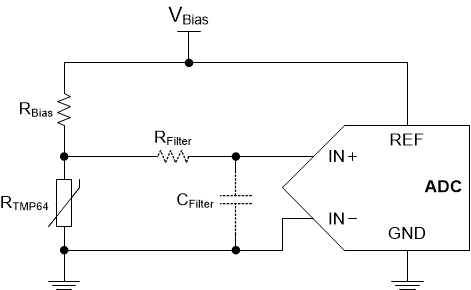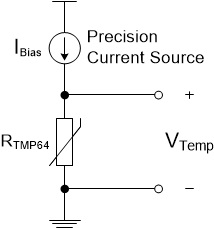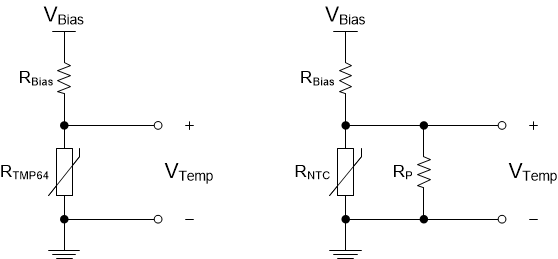SNIS212C December 2019 – September 2020 TMP64
PRODUCTION DATA
- 1 Features
- 2 Applications
- 3 Description
- 4 Revision History
- 5 Device Comparison Table
- 6 Pin Configuration and Functions
- 7 Specifications
- 8 Detailed Description
- 9 Application and Implementation
- 10Power Supply Recommendations
- 11Layout
- 12Device and Documentation Support
- 13Mechanical, Packaging, and Orderable Information
Package Options
Mechanical Data (Package|Pins)
Thermal pad, mechanical data (Package|Pins)
Orderable Information
9.2.1.2 Detailed Design Procedure
The resistive circuit divider method produces an output voltage (VTEMP) scaled according to the bias voltage (VBIAS). When VBIAS is also used as the reference voltage of the ADC, any fluctuations or tolerance error due to the voltage supply is canceled and does not affect the temperature accuracy. This type of configuration is shown in Figure 9-2. Equation 2 describes the output voltage (VTEMP) based on the variable resistance of the TMP64 (RTMP64) and bias resistor (RBIAS). The ADC code that corresponds to that output voltage, ADC full-scale range, and ADC resolution is given in Equation 3.
 Figure 9-2 TMP64 Voltage Divider With an ADC
Figure 9-2 TMP64 Voltage Divider With an ADC

where
- FSR is the full-scale range of the ADC, which is the voltage at REF to GND (VREF)
- n is the resolution of the ADC
Equation 4 shows whenever VREF = VBIAS, VBIAS cancels out.

The engineer can use a polynomial equation or a LUT to extract the temperature reading based on the ADC code read in the microcontroller. The Thermistor Design Tool should be used to translate the TMP64 resistance to temperature.
The cancellation of VBIAS is one benefit to using a voltage-divider (ratiometric approach), but the sensitivity of the output voltage of the divider circuit cannot increase much. Therefore, not all of the ADC codes are used due to the small voltage output range compared to the FSR. This application is very common, however, and is simple to implement.
The engineer can use a current source-based circuit, like the one shown in Figure 9-3, to have better control over the sensitivity of the output voltage and achieve higher accuracy. In this case, the output voltage is simply V = I × R. For example, if a current source of 100 µA is used with the TMP64, the output voltage spans approximately 5.5 V and has a gain up to 40 mV/°C. Having control over the voltage range and sensitivity allows for full utilization of the ADC codes and full-scale range. Similar to the ratiometric approach above, if the ADC has a built-in current source that shares the same bias as the reference voltage of the ADC, the tolerance of the supply current cancels out. In this case, a precision ADC is not required. This method yields the best accuracy, but can increase the system implementation cost.
 Figure 9-3 TMP64 Biasing Circuit With Current Source
Figure 9-3 TMP64 Biasing Circuit With Current SourceIn comparison to the non-linear NTC thermistor in a voltage divider, the TMP64 has an enhanced linear output characteristic. The two voltage divider circuits with and without a linearization parallel resistor, RP, are shown in Figure 9-4. Consider an example where VBIAS = 5 V, RBIAS = 47 kΩ, and a parallel resistor (RP) is used with the NTC thermistor (RNTC) to linearize the output voltage with an additional 47-kΩ resistor. The TMP64 produces a linear curve across the entire temperature range while the NTC curve is only linear across a small temperature region. When the parallel resistor (RP) is added to the NTC circuit, the added resistor makes the curve much more linear but greatly affects the output voltage range.
 Figure 9-4 TMP64 vs. NTC With Linearization Resistor (RP) Voltage Divider Circuits
Figure 9-4 TMP64 vs. NTC With Linearization Resistor (RP) Voltage Divider Circuits